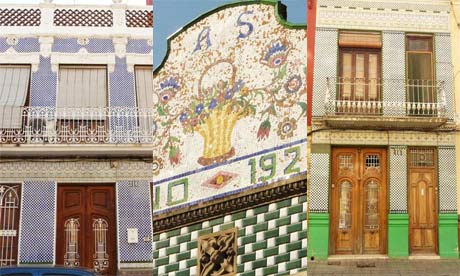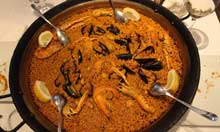Head for Valencia's fishermen's quarter – before the bulldozers get there
Valencia has developed into one of Spain's coolest cities but, as bulldozers threaten one of its oldest and most atmospheric barrios, what is the price of such rapid progress?
Art house ... colourful facades in Valencia's Cabanyal district. Photograph: Jason Webster
"To be alone in Valencia," theatre critic Kenneth Tynan quoted an American as saying, "is to be permanently 20 minutes this side of suicide."
Spain's third-largest city has come a long way since Tynan himself dubbed it the "world capital of anti-tourism" 40 years ago. The old quarter has been tarted up, Santiago Calatrava's space-age fantasy, the Ciudad de las Artes y las Ciencias, has been virtually completed, the America's Cup sailed into town in 2007, and it hosted a Formula One grand prix a year later.
From being a slightly forlorn and forgotten sister in the Spanish family, it became a hot destination.
With so much new-found pride in their city, it was easy to imagine that Valencians would never again commit the architectural crimes of the past, that the knee-jerk cementing of the coastline and construction of characterless apartment blocks was a thing of painful memory.
We were wrong.
 Enjoy some top Paella in the Cabanyal district. Photograph: Marco Balzani/Getty Images/Flickr RF
Enjoy some top Paella in the Cabanyal district. Photograph: Marco Balzani/Getty Images/Flickr RF If you are in the Valencia area this year, be sure to visit the old fishermen's quarter, El Cabanyal. This working-class jewel of art-nouveau style – officially a "protected historical zone" – may not exist in its present form for much longer. If the city hall planners get their way, bulldozers will continue punching a large hole through the middle of it to extend a modern avenue from the city centre to the sea. Residents have protested vociferously, and the highest court in the country – the Tribunal Constitucional – has ordered a stop to the demolition, but Valencia's Mayor, Rita Barberá, has insisted she'll go ahead.
In existence since the 13th century, El Cabanyal has become the common term for what are in fact three neighbourhoods stretching north from the port – El Canyamelar, El Cabanyal and Cap de França – and owes its name to the rows of thatched fishermen's cabins, also known as barracas, that used to line the beachfront. The remains of some can be seen today, with their characteristic steep – formerly thatched – roofs.
A major fire in the late 1700s, and the growing affluence of the inhabitants as the port was expanded, meant that most barracas were replaced around the turn of the century by elegant two- and three-storey townhouses. The Moors first brought a ceramic industry to the Valencia area more than 1,000 years ago: drawing on an ancient local tradition of covering facades with brightly coloured tiles, residents finished off their new homes in the styles in fashion at the time.
Art nouveau may be the dominant flavour, but you'll find anything from baroque to eclecticism, and even a few examples of something approaching art deco. Residents will tell you that their grandparents weren't overly concerned with the purity of the design when they were building these houses – that they simply used whatever materials appealed to them. A Mediterranean sensibility to light and colour and a certain degree of keeping up with the Joneses means the area is unique, leading more than one visitor to describe it as "an open-air museum".
Concentrating on maritime shades of blue, green and white, the tiles are often spaced to create a zigzag, or checkerboard pattern, and the effect is vibrant and harmonious. You may find the face of a sea god staring out at you from above a doorway, or a mosaic depiction of pesca dels bous – a kind of dragnet fishing that involved pulling laden boats back on to the beach using oxen, a scene local artist Joaquín Sorolla depicted in some of his impressionist paintings.
This is a barrio for taking a slow stroll through, criss-crossing from one street to another, and getting to know what is still a working community with a strong sense of identity. Although El Cabanyal has officially been part of the city for centuries, the people round here still talk about "going to Valencia" if they are travelling to the city centre.
Start near the port end and wander along Carrer de la Reina. This is the main artery running north to south; all the streets are on a grid system, with the houses oriented east to west to benefit from the cooling easterly winds off the sea in the summer. As you meander along, you'll eventually cross Avinguda Mediterrània, leading from the sea to the indoor market. This is where El Cabanyal proper begins, and the area most affected by the city's plans. It is also where you'll find some of the most enchanting houses.
Find Carrer Barraca, and the streets parallel to it, and let your eyes wander. On Carrer Progrès, look out for No 262, with its turquoise-and-white tiled facade, amphora designs above the windows in mosaic, and griffin-head drains running off the terrace roof. Opposite, No 279, finished in green and white, is more sedate, but no less spectacular. Around the corner on Carrer Padre Luís Navarro, the narrow fronting of No 309 has been covered in modernist tiles with delicate vegetable motifs in green and ochre.
Many of these houses run through from one street to the next. Get chatting with the locals and you may be invited inside for a peek. Large pitch-pine doors open up into living rooms tiled with more intricate designs, with elegantly carved window frames and arched ceilings. You can even stay in one of them: the B&B Cabanyal is on Carrer Josep Benlliure (+34 963 364521. Recently renovated, it is run by a friendly young couple who are more than happy to tell you all you want to know about the local area and its traditions, or they can put you in touch with a group who provide guided walks through the streets. It's also excellent value, starting at just €20pp a night, including breakfast.
(A quick word of warning – thanks to years of official neglect and degradation, this area has become a haven for drug dealers. You're almost certainly safe, but it's best to be aware.)
Good places to eat in the Cabanyal, particularly for fish, are not hard to find. The Casa Montaña (Carrer Josep Benlliure 69) is a former bodega that has become one of the best-known restaurants/tapas bars in the city, not least for its vast wine cellar (20,000 bottles). El Cabanyal, (Carrer de la Reina 128), which is right in the planner's line of fire, is known to be frequented by the very people who now want to tear it down. Meanwhile Casa Guillermo (Carrer Progrès 15) is famous as the home of the local "anchovy king".
But my favourite is the Bodega La Pascuala (on Carrer Eugènia Viñes 177), just a street away from the beach. Noisy, busy and a bit grimy, it's an authentic neighbourhood bar, with rows of dusty brandy bottles lining the walls, and it offers cheap, working-man-size sandwiches with names such as "The Republican" and the "Bribe-Giver", and delicious paella on Friday lunchtimes. Perfect for filling up after a dip in the sea.
Thankfully, Valencia is today far from being the suicide-inducing city that Tynan knew, but as you knock back a glass of brandy, it's hard not to reflect that the place you're sitting in may soon be a pile of rubble. The future of El Cabanyal looks uncertain, but while it's still standing, visitors have a last chance to explore this unpolished gem on the Mediterranean before it is destroyed for ever.
• The neighbourhood pressure group is Plataforma Salvem el Cabanyal; its members can organise guided walks through the area. Ryanair flies to Valencia from Bournemouth, Bristol, East Midlands, Liverpool and Stansted; easyJet flies from Gatwick
Jason Webster's detective novel set in Valencia, Or the Bull Kills You, will be published by Chatto & Windus in February 2011